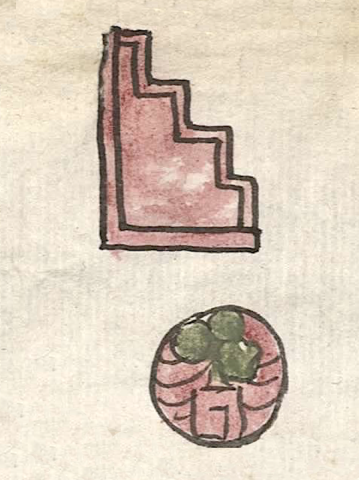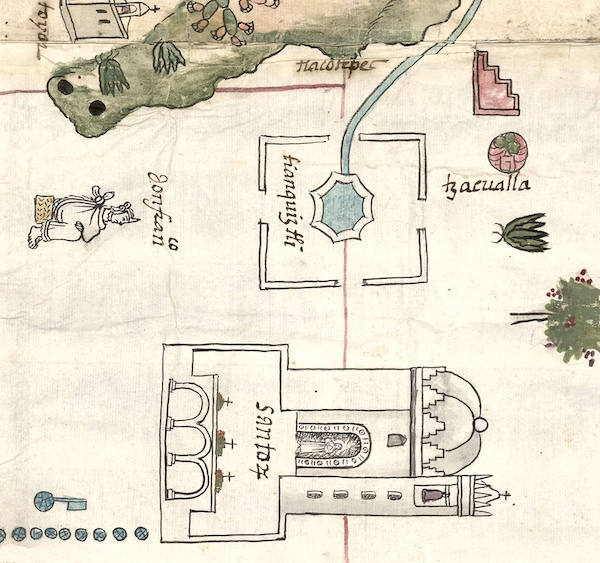Tzacuallan (CmpRG)
This is a compound glyph naming the community called Tzacuallan. It is featured in the 1580 Relación Geográfica de Cempoala (originally, Cempohuallan, and today, Zempoala, Hidalgo). It consists of two separate elements. The first one is a stepped structure facing to the right. It is outlined in black with a red interior. Below this is a round figure, also with a red interior, with a small rectangular element on its bottom edge and a series of curved black lines on each side above this. Near the top are three roughly circular elements outlined in black and filled with a grey pigment. Both of these figures relate to the noun tzacualli, which has multiple meanings. The stepped figure stands for a pyramid or temple, while the one below it represents a stony mound were ceremonies were performed, with the dark green-colored elements apparently acting as semantic indicators for the platform's stony nature (as may also be true for some of its other internal elements). The locative -lan, near, with, etc., is not visualized.
Robert Haskett
Tzacuallan was one of the four cabeceras making up the municipality of Cempohuallan. Together, the two figures expressing its name appear to represent the site of a pre-1519 temple with a ceremonial platform at its base. Why the artist who painted these elements chose to represent tzacualli in this way is not known, but the pairing not only emphasizes the meaning of the glyphs, but also suggests that this was a significant site prior to the arrival of the Spanish colonizers on the scene. While the two glyphs are not associated directly with a church, which is the usual way an inhabited place is flagged on the map, they are placed very near to the large representation of the region’s major marketplace (tianquiztli), and not too far from a large drawing of the Franciscan monastery church. The seated figure of the cabecera’s gobernador (chief municipal officer) of 1580, don Francisco de Guzmán, is also nearby (see the historical contextualizing image). Another type of ritual platform, a teapetlatl, appears elsewhere on the map (see below). For more information about the RG map, see Biblioteca Digital Mexicana, A.C., http://bdmx.mx/documento/mapas-relaciones-geograficas-cempoala-epazoyuca... Mundy, Barbara E., “Mapping Babel: A Sixteenth-Century Indigenous Map from Mexico,” The Appendix, 1:4 (October 2013), Mundy (1996), and Ballesteros García (2005), 54, figure 9, who, however, does not account for the two separate elements in the name.
Robert Haskett
tzacualla
Tzacuallan
Robert Haskett
1580
Robert Haskett
pyramids, pirámides, platforms, plataformas, temple, templos, nombres de lugares

tzacual(li), a small hill; a temple or a pyramid, https://nahuatl.wired-humanities.org/content/tzacualli
tzacual(li), mound or small hill of rocks where ceremonies are sometimes done, https://nahuatl.wired-humanities.org/content/tzacualli-0
-lan, with; next to; in; between; in the company of; below; to; near, https://nahuatl.wired-humanities.org/content/lan
cerca de la pirámide, la plataforma
Robert Haskett
Relación de Cempoala - University of Texas Libraries Collections. 1580-11-01. https://collections.lib.utexas.edu/catalog/utblac:f87917e2-e3c9-4eb2-a83...
Materials that are in the public domain (such as most of the maps in the PCL Map Collection) are not copyrighted, and no permission is needed to copy them. You may download them and use them as you wish. The image appears here courtesy of the University of Texas Libraries, The University of Texas at Austin. If you do publish anything from this database, please cite the Visual Lexicon of Aztec Hieroglyphs.





